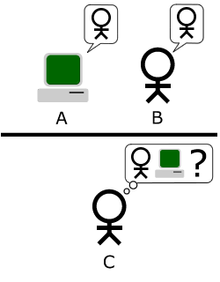Turing test

The Turing test is a test to see if a computer can interact with a person. The human should not be able to realise it is interacting with a computer.
Alan Turing thought that if a human could not tell the difference between another human and the computer, then the computer had shown intelligent behaviour.[1]
Test setup[change | change source]
A person has a telegraph, and is connected to two communication partners. One of the two correspondents is a machine. The person can ask anything with the telegraph. If the person cannot tell which of the two is the machine more than 50% of the time, then the machine is said to be intelligent.
Later on, people narrowed down the test. A human is unlikely to know everything. Therefore, both the human and the machine would be specialists in some field of knowledge. So would the person asking.
Media[change | change source]
The comic strip Dilbert makes several mentions to the PHB (Pointy Haired Boss) failing the Turing test.
References[change | change source]
- ↑ Harnad, Stevan 2008. The Annotation Game: on Turing (1950) on Computing, Machinery and Intelligence. Archived 18 October 2017 at the Wayback Machine. In: Epstein, Robert & Peters, Grace (eds) Parsing the Turing Test: philosophical and methodological issues in the quest for the thinking computer. Springer.
Related pages[change | change source]
Other websites[change | change source]
- "Machines Who Think, on season 2, episode 5". PBS. Scientific American Frontiers. Chedd-Angier Production Company. 1991–1992. Archived from the original on 2006.
{{cite web}}: Check date values in:|archivedate=(help)
